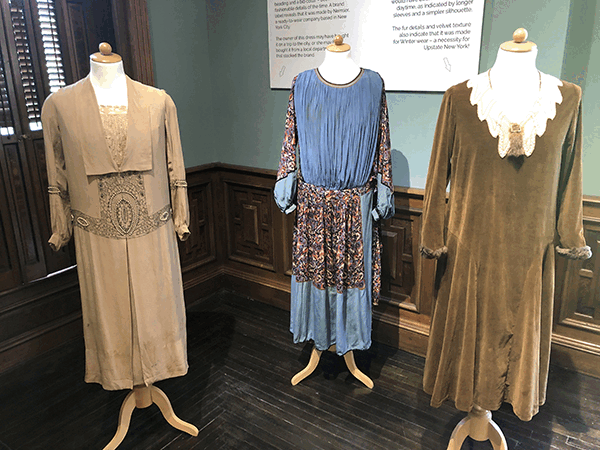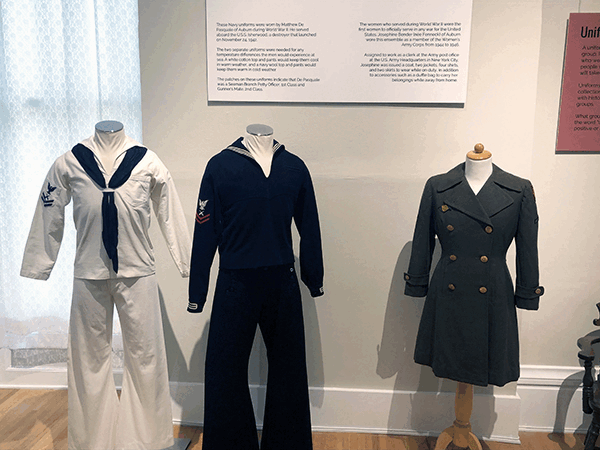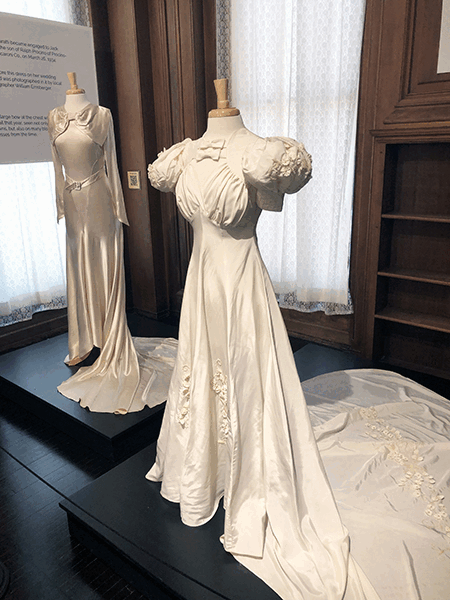Cayuga Museum's Exhibit “Fabrication: Telling Stories Through Clothing”
-by Carol White Llewellyn
 Although I grew up just outside of Auburn, NY, I don’t recall ever visiting Cayuga Museum of History and Art. In those days, I wasn’t as enamored of museums and history as I am today.
Although I grew up just outside of Auburn, NY, I don’t recall ever visiting Cayuga Museum of History and Art. In those days, I wasn’t as enamored of museums and history as I am today.
On a Saturday in early May, three close friends and I met in Auburn to visit the museum, and see the exhibit Fabrication: Telling Stories Through Clothing that runs through December 30, 2023. The museum celebrates Auburn and Cayuga County, shedding a light on some of Auburn's founding families and the history of the region.
The museum is located in a historic mansion at 203 Genesee Street that was once home to two of Auburn’s prominent families, the Willards and the Cases, who were related by marriage. It is also the location of the Case Research Lab, built in a former green house, in which Theodore and his father Willard Case pioneered the field of “talkies,” or film that incorporated sound. The carriage house adjacent to the mansion is home to a theater.
 The East wing of the museum houses the former location of Dr. Sylvester Willard’s in-home medical office, complete with exam table and medical equipment of the day. Part of the exhibit is a display detailing the many medical advances that came out of the Civil War. I guarantee you’ll be thankful you didn’t have to endure a medical procedure in the 19th Century! A beautiful Tiffany glass window from 1870 illuminates the far end of the former medical office.
The East wing of the museum houses the former location of Dr. Sylvester Willard’s in-home medical office, complete with exam table and medical equipment of the day. Part of the exhibit is a display detailing the many medical advances that came out of the Civil War. I guarantee you’ll be thankful you didn’t have to endure a medical procedure in the 19th Century! A beautiful Tiffany glass window from 1870 illuminates the far end of the former medical office.
Up a steep and stunning wooden staircase (there is an elevator, for those who prefer) you’ll discover the history of Auburn’s Correctional Facility, one of the oldest in the country, and which was built not long after Auburn was founded. For many years, the prison’s harsh treatment of prisoners was considered a “model” for other prisons across the country. The exhibit also explores the history of penal reform and the role mental health issues have played in prisons.
Another area of the second floor showcases art exhibits. Tyrone Johnson-Neuland’s Depictions of Panama was a bold expressionistic display of the urban and rural landscapes that inspired him during his travels. This display is on view only until May 27.
 The exhibit Fabrications was the reason I’d proposed visiting the museum. What I found especially fascinating about this exhibit is that not only do you learn about the fabric from which the clothing was made, its style, era and use, but you also learn about the Auburn resident who wore it. Sometimes, you might even learn the occasion on which it was worn. For example, there were several bridal dresses attributed to Auburn residents over a span of decades, including some that might surprise you in length and color. The exhibit included everyday outfits, military uniforms, formal attire, and even an early scout leader uniform.
The exhibit Fabrications was the reason I’d proposed visiting the museum. What I found especially fascinating about this exhibit is that not only do you learn about the fabric from which the clothing was made, its style, era and use, but you also learn about the Auburn resident who wore it. Sometimes, you might even learn the occasion on which it was worn. For example, there were several bridal dresses attributed to Auburn residents over a span of decades, including some that might surprise you in length and color. The exhibit included everyday outfits, military uniforms, formal attire, and even an early scout leader uniform.
We all got a chuckle when my friend Donna shared that the long 1970s; gown was an exact replica—in style, if not fabric pattern—of her prom dress that, when her daughters and their friends played dress up, was the outfit no child wanted to wear.
 It was remarkable how well preserved the clothing was, even the gown with the bustle, worn shortly after the Civil War. The photos shown here are only a small sample of the delightful collection.
It was remarkable how well preserved the clothing was, even the gown with the bustle, worn shortly after the Civil War. The photos shown here are only a small sample of the delightful collection.
The exhibit, and the entire museum, was interesting and well-curated, and there were QR codes with information about specific aspects of the museum to enrich your visit. You should allot a minimum of an hour to go through it, and if you want to add on the Case Research Lab—which we did not have to to see— more time.
The museum is open Wednesday through Saturday from 11 am to 4 pm, and admission ranges from free for Members and children 12 and under, to $10 for General Admission. If you wish to view the Case Research Lab, add an additional $2.
For more information, visit: CayugaMuseum.org.

Carol White Llewellyn is Editor of Beyond the Nest.

